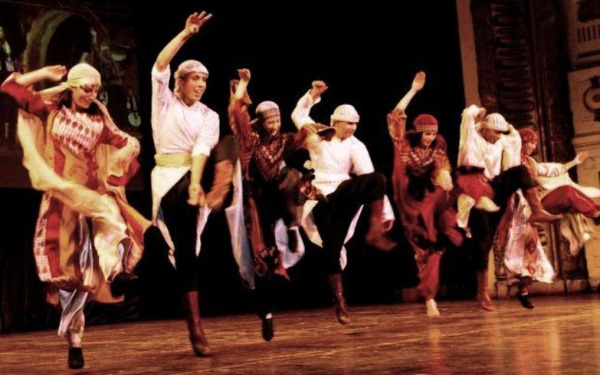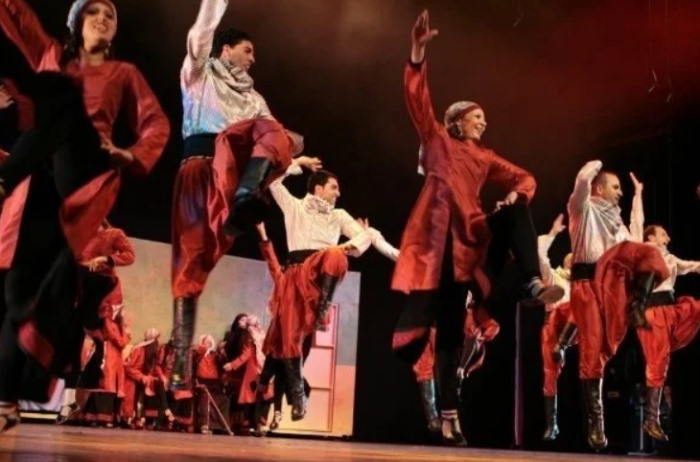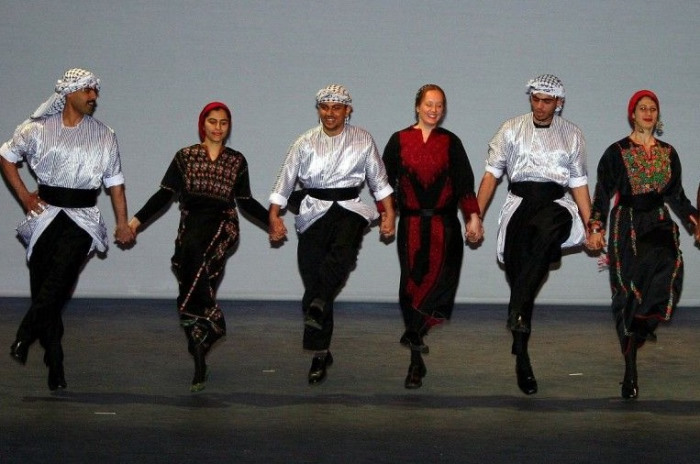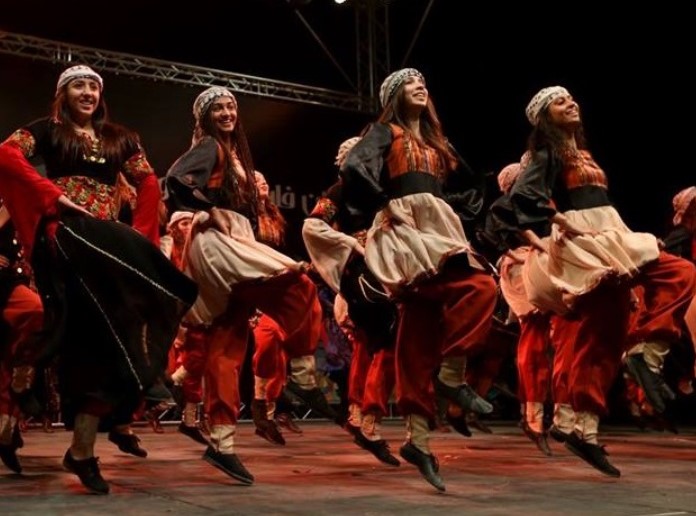In many Arabic-speaking countries, whenever there is a joyous occasion like a marriage or a festival, you will definitely spot at least one group performing Dabke.
The Dabke dance (also called Dabka) is a folk dance originating from the Levantine regions, like Palestine, Jordan, Lebanon, and Syria.
If you’re seeking a deeper view into Arabic/Levantine culture, Dabke is one of the best topics to investigate. Having been around and regularly performed for hundreds of years, the dance is a cultural jewel of the region and the people.
This article has everything that you need to know about Dabke!
Table of Contents
What Is Dabke Dance?
The name “Dabke” is thought to have been derived from the Levantine Arabic word dabaka (دبكة), which can be roughly translated to “stamping of the feet”. It perfectly describes the essence of the dance.
Dabke is characterized by people stamping their feet rhythmically in lines or circles. The dancers’ arms will often be interlocked with one another.
They will usually sing or chant along with the Dabke music in the background, too.
The formation of dancers will form from left to right. At the head of the formation is the leader (called raas or lawweeh), who sets the rhythm and the steps for the rest.
The lawweeh mustn’t just be an expert at Dabke, but he must also be accurate, quick, and capable of improvisations. The leader will continuously alternate between facing the dancers and the audience.
Dabke is an incredibly joyous and energetic kind of communal dance. It is only ever performed on happy occasions. It is a very popular type of wedding dance in Palestine, for example.

Dabke Dance Origin
Like many folk dances around the world, not much is known about the history of Dabke.
Some historians said that the feet-stamping motion of Dabke was derived from ancient fertility rituals of the Canaan civilization. The Canaanite performed the same “jumps” in their rituals to chase away evil spirits and protect the crops from being harmed.
Other historians then theorized that Dabke was a descendant of Phoenician dances dated thousands of years back.
There’s also a group of historians that think Dabke evolved from the process of house-building in old Levantine areas.
When people were still building mud houses, they needed to stomp the rooftops to keep the mud from cracking. Eventually, the stomping motion turned into Dabke!
Most sources agreed that the dance form that’s later known as Dabke appeared in the mountainous areas around the Mediterranean coastline and the Tigris river.
Some of the earliest adopters of the dance were the people in villages in the Levant (Lebanon, Syria, Palestine, Jordan, Iraq) as well as certain Bedouin tribes in the regions.
Check more: Arab Dance: History, Popular Moves & More
Types of Dabke
Dabke is a very diverse dance with many variations. The people from one country or one area may have completely different interpretations of Dabke.
Dance historians have recorded over 20 different variations of Dabke. However, we’re certain that there are more than just these 20 types.
There are 6 popular variations. They are widely practiced and are best known.
Major Dabke Variations
1. Al-Shamaliyya (الشمالية)
Al-Shamaliyya is said to be the most common variation of Dabke. The lawweeh dances at the front of the formation and sets the rhythm.
Behind him will be both men and women dancing with their hands interlocked, formed into either a line or a circle.
Usually, a performance will start with the musician playing a solo on the mijwiz or yarghoul (traditional instruments). Accompanying the music will be one or two singers.
On top of the music, the whole group of dancers will dance in synchronized steps to the beat, led by the lawweeh.
After the singers have finished their song, the lawweeh will break from the formation and dance solo. He will watch the steps of the dancers in the formation.
When they’re in sync and on beat, he will instruct them to slow down and execute a crossing movement (put the right foot in front of the left foot).
The lawweeh will continue to lead and regulate all of the dancers’ rhythms after the crossing. At this point, other guests or bystanders may also join the Dabke group.
Like most forms of Dabke, Al-Shamaliyya is strictly danced in happy, joyous, or celebratory settings, such as marriages, birthdays, festivals, and holidays.
2. Al-Sha’rawiyya (الشعراوية)
While Al-Shamaliyya is a communal dance that is for everyone regardless of sex, Al-Sha’rawiyya is a men-only dance. This variation feels militant, almost like a martial dance, and is characterized by strong steps and stomps.
The lawweeh continues to play an important role in this type of Dabke. He is the one to set out the rhythm, pacing, and the moves for everyone else.
3. Al-Karaadiyya (الكرادية)
Slower and more relaxed, Al-Karaadiyya doesn’t require a lawweeh. Since the tempo is easier to follow, people can follow one another without the guidance of a lead dancer.
Beside slower movements, Al-Karaadiyya also stands out by having an azif (عازف) – basically a flute player – stands and plays in the middle of the dancing circle.
4. Al-Farah (الفره)
Al-Farah is the mirror opposite of Al-Karaadiyya. Instead of being slow and relaxed, Al-Farah is frantic and extremely energetic. Movements consist of big hops, leaps, and jumps around the stage.
Because of that, it is mostly a men-only dance. Anyone who wants to partake in Al-Farah also needs to have a certain level of physical fitness, too.
5. Al-Ghazal (الغزل)
Similar to Al-Farah, Al-Ghazal requires fitness from the dancers. It is characterized by three strong stomps on the right foot. After a while, the motion can get very tiring.
6. Al-Sahja (السحجة)
Al-Sahja is a Palestinian and Jordanian dance, but these days, it is a lot more popular in Palestine.
The dance grew in popularity after the British Mandate for Palestine. Al-Sahja is mostly danced in the northern and central areas of the region.
In the south of Palestine, Al-Sahja is separated into two types: As-Samir (السامر) and Al-Dahiyya (الدحية).
- As-Samir can look very entertaining if you’re able to watch it in person. It consists of two rows of men standing against opposite walls. They will take turns competing with one another in folk poetry. Sometimes they will even invent clever insults and retorts (all in good fun, of course!)
- Al-Dahiyya is basically the same thing, but a female dancer will be performing in the middle of the two rows of men. The men will compete with one another for her attention and favor. Sometimes, they will even give her money.
You will often see Al-Sahja being performed the night before a wedding and being hosted for the groom. It is basically the Palestinian analog of a Western bachelor party.
Most of the men in the village will attend the Al-Sahja, but attending is almost mandatory for the men who directly take part in the wedding or are close to the groom.
Minor Dabke Variations
Aside from the 6 major types above, there are dozens of minor Dabke variations.
- Habel Mwadea’ (حبل مودع)
Habel Mwadea’ is the Jordanian interpretation of dabke. Similar to the Palestinian Al-Shamaliyya, it is danced by both men and women.
- Al-Tas’awiyya (التسعاوية)
If you want to watch a performance of Al-Tas’awiyya, you’ll need to visit Ma’an. The dance is mostly performed in this city in South Jordan.
Al-Tas’awiyya is also called Al-Ma’aniyya (المعانية).
- Al-Darrazi (الدرازي)
In Al-Darrazi, the music is produced by a Mijwiz, a traditional Middle Eastern musical instrument. The dance is very popular in both Jordan and Palestine.
- Al-’Askariyya (العسكرية)
Al-’Askariyya is a type of martial dance. In Arabic, the name is basically “Military Dabke”. In Arabic countries, women rarely participate in this type of dance because it requires a lot of energy.
- Al-Joufiyya (الجوفية)
Al-Joufiyya is quite similar to Al-Sahja in form. Two groups will stand facing one another, singing in a call-and-response fashion.
One group will start the song, then the other one will respond accordingly with Jordanian folkloric songs.
- Al-Ghawarneh (الغوارنة)
Al-Ghawarneh is one of the fastest Dabke variations out there. It is mostly performed in the Jordan Valley area.
It’s also known as Deir ’Ala (دير علا).
- Wahad w Nos (واحد ونص)
The name Wahad w Nos basically means “one and a half”. It is usually performed by a group of ten or more dancers, called a dbeka.
The dance will first start with the entire ensemble dancing in place with a simple hopping movement.
Then, one of the dancers will separate from the dbeka and dance solo, striking out with his left foot, then his right foot.
- Abu ’Alanda (أبو علنده)
Abu ’Alanda is characterized by the dbeka jumping five light jumps. After that, they will shift to the left, then to the right, and perform one and a half movements. Repeat.
- Al-Aqabawiyya (العقباوية)
So-called because it is mostly performed in the coastal city of Aqaba, South Jordan. It is the most popular local dance in the area.
- Al-Ramthawiyya (الرمثاوية)
This dance is performed in the far north of Jordan in the city of Ar-Ramtha. Just like Al-Aqabawiyya, it is the most popular folk dance in the city.
- Al-Hashi (الحاشي)
Al-Hashi (also known as the Al-Hashi Sword Dance) is a dance that’s performed exclusively by women. The dancers will perform while wielding sticks or swords to the music based on several classical poems.
- Al-Farradiyya (الفرّادية)
Similar to Al-Hashi, this is a minor variation of Dabke that’s performed exclusively by women.
- Al-Jamma’iyya (الجمّاعية)
Al-Jamma’iyya is another kind of special dance for women only.
- Al-’Adiyya (العادية)
Also known as Al-Dalo’una (دبكة الدلعونا), this type of Dabke can be danced in many different rhythms, slow and fast alike. The music is played by traditional instruments.
It is popular in virtually all of the Levantine, from Palestine and Lebanon to Syria and Jordan.
Dabke in Palestinian Culture
While Dabke is a dance that’s present in virtually all of the Levantine countries, Palestine stands out from the rest as the one country that truly embraces the dance.
Palestinians more or less sewn it into the fabric of their culture.
As a result, you will find many Palestinians performing Palestinian traditional Dabke dance during national holidays as a way to express their national identity and pride.
Ever since the area became plagued by armed conflicts, Dabke has undergone a period of revival.
People see performing and practicing Dabke as a way to preserve the Palestinian people’s customs, traditions, and ways of life.
In Palestine, Dabke is a nearly unskippable part of weddings. You can see performances to the north of Palestine, around the Hebron area.
It’s also performed by people in the south of Marj Ibn Amer and Wadi Ara, as well as around the northern parts of the West Bank.
Three popular variations of Dabke in Palestine are Al-Shamaliyya, Al-Sha’rawiyya, and Al-Karaadiyya.
For Palestinian women, there’s the Dabke Niswaniyyah, which is a women-only dance. Each type of Dabke is danced to a unique set of songs. The theme usually revolves around love.
Dabke Dance Techniques
Dabke is a communal dance, which means it’s danced by everyone in a community. As such, the steps are very simple and easy to learn.
A basic Dabke pattern is quite similar to a 6-count line dance. It has 6 steps and the dancers usually move to the right.
Ideally, if you want to practice, you should have two other friends with you. The dance should be started in a line, with your hands interlocked with your neighbors.
- Make a step to the right with your left foot. Swing your left foot over your right foot in a crossing motion. This is called a “cross-over” and it is the most basic step in Dabke.
- Return to your starting position after the shift to the right.
- Repeat the rightward cross-overs again.
- Kick your left foot forward at a 45° angle relative to your right foot. Toes should be pointed upward, not sideward.
- As you kick your left foot up, transfer to a raise. Bend your left knee and bring your thigh up as high as possible. Preferably until your thigh is at a 90° angle to your right leg.
- Now, stomp hard on the ground. The stomping part is absolutely crucial to Dabke. After all, the name of the dance is literally “stomping of the feet”.
Repeat all of the steps again. If you’re practicing, do it as fast as you can until you’re used to the pattern. If you’re performing, either follow the lead dancer (lawweeh) or the beat of the music.
Sometimes, the chain of Dabke dancers will reverse direction from right to left. This is totally normal. Just reverse your cross-overs. Instead of crossing with your left foot, do it with your right foot!
Note that this is the most basic Dabke pattern. There are many variations that you can try after you’ve mastered the basic steps.
Dabke Dance Costumes
Once again, Dabke is a communal dance. So, people usually aren’t very strict when it comes to apparel. You won’t be asked to wear Dabke dance clothes.
If you’re invited to an Arabic wedding with a Dabke performance, you can join the dance wearing whatever so long that it’s appropriate for the occasion and your clothing allows you to kick your legs.
However, in certain cases, Dabke does have a dress code. In many countries, professional Dabke dancers will wear the country or the area’s traditional costumes.
Men will usually wear loose trousers and shirts combination or a traditional thobe (a type of long robe). They may also wear a type of head covering like the keffiyeh, which is a kind of scarf.
Women may wear a black abaya robe that’s embroidered in golden threads in patterns of flowers and roses.
Famous Dabke Dancers
Zvi Gotheiner
While Zvi Gotheiner isn’t exactly a dancer, this Israeli choreographer is credited as the one who brought this Arabic dance to theaters and stages in the Western world.
He integrated many Dabke elements into his dance company’s repertoire (ZviDance) to great success and critical acclaim.
Gotheiner has received commissions from the Zurich Tanz Theater, the American Dance Festival, and many other notable places.
He’s also honored with many awards, like two New York Foundation for the Arts Choreography fellowships and the National Arts Club Weiselberg Award.
Bassam Abou Diab
Being a Lebanese dancer, Bassam Abou Diab grew up with Dabke. His focus lies in both contemporary dances as well as folkloric dances like Dabke.
As a result, Bassam has produced many beautiful performances with Dabke elements.
He has starred in many of Lebanese most beloved plays and shows and is currently a part of the Maqamat Dance Company.
Other than performing, Bassam is also a teacher. He regularly hosts many dance workshops in Lebanon. At these workshops, he teaches Lebanese Dabke dances, and contemporary Dabke, as well as contemporary dance, rituals, and movements.
His workshops are available not just in Lebanon, but also in Spain, Lithuania, France, Italy, and Germany.
Barak Marshall

Similar to Zvi Gotheiner, Barak Marshall isn’t exactly a dancer. Rather, he’s a choreographer. Nonetheless, his contribution to the spread of Dabke is worthy of note.
Barak Marshall is one of Israel’s best dance artists. He once worked as the house choreographer for the famous Batsheva Dance Company.
While most of his performances have to do with Israeli folk dances, he also integrated many Arabic elements into his choreographies. And of course, many of these elements were inspired by Dabke.
Dabke Dance Music
Dabke technically isn’t a picky type of dance. You can dance to any sort of music so long that it is rhythmic. The more energetic and fast the dance is, the faster the tempo of the music should be.
However, if you’re going to practice traditional Dabke, it’s recommended that you pick suitable music. Depending on the variation, there may be a special set of music that you must dance to. For example, Al-Hashi.
Traditional Dabke is danced to music produced by traditional instruments, ranging from hand drums to ouds. A Dabke band may improvise their music, or re-play popular songs. Certain songs will even have lyrics and singers.
For modern Dabke, the music can be produced by a blend of traditional instruments and modern instruments like electric guitars. As a matter of fact, some songs are entirely synthesized on a computer.
Kinds of music for contemporary Dabke are instrumental for the most part. Very little singing is involved.
Dabke can also be danced without any music at all! Just clap your hands to a rhythm.
Songs
Dabke songs also come in genres. For example, popular songs like Dal Ouna (دلعونا), Al Jafra (الجفرا), Al Dahiyya (الدحية), and Zareef il-Tool (ظريف الطول) are considered song genres by themselves.
Basically, each one of these has a specific rhythm. Singers and musicians then pick the rhythm to build different songs with totally different lyrics.
Expert Dabke dancers can tell you exactly the genre just by listening to the rhythm.
Instruments

A Dabke band can use many instruments. Most popular is the oud, a type of lute, and the mijwiz, which is similar to a reed clarinet.
In the percussion family are the tablah hand drum and the daff, which is similar to a tambourine.
The arghul is and the Shubabeh, both of which are woodwind instruments.
Dabke Dance Competitions
Dabke is performed on a local, national, as well as international scale. Most of these competitions usually take place in the Arab World.
For example, an international Dabke competition was hosted in Lebanon in 2017.

There are many Dabke competitions in western countries like the US and Canada, too.
World’s Most Impressive Dabke Performances
Using Dabke, people have achieved many special world records.
In 2011, a long human chain of 5,050 dancers was made in the village of Dhour El Choueir. It’s still the longest human chain in the world.
Movie About Dabke Dance
- Dabke Time (Short Documentary Film, 2017)
- Bosta (Musical Movie, 2005)
Dabke Dance Gallery

Final Words
The Dabke dance is a special part of the culture and the people of not just the Levantine countries, but also the Arab World as a whole.
Viewing a performance is basically looking at thousands of years of history and the evolution of the people here.
And since Dabke is such a simple dance, why not get up from your spectator seats and try it for yourself?



